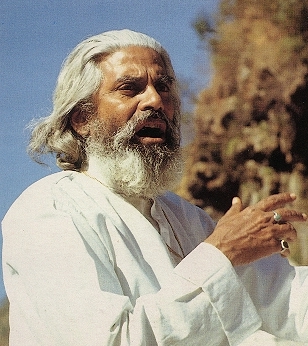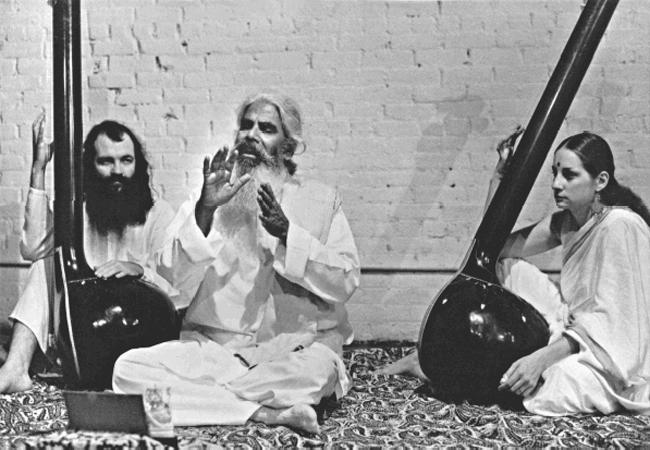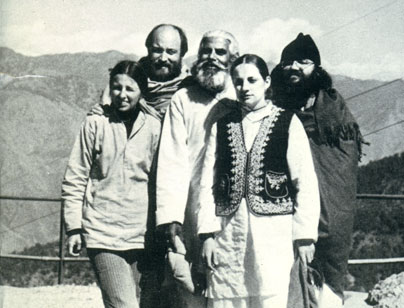 In 1970, Pran Nath travelled to New York to visit the American composer La Monte Young and visual artist Marian Zazeela, who heard his first issued recording, Earth Groove: The Voice of Cosmic India. In 1972, he established the Kirana Center for Indian Classical Music in New York City and stayed in the US for the rest of his life. He taught at several universities and attracted a strong following among the American minimalist composers.[4]
In 1970, Pran Nath travelled to New York to visit the American composer La Monte Young and visual artist Marian Zazeela, who heard his first issued recording, Earth Groove: The Voice of Cosmic India. In 1972, he established the Kirana Center for Indian Classical Music in New York City and stayed in the US for the rest of his life. He taught at several universities and attracted a strong following among the American minimalist composers.[4]
In the early Seventies, Guruji’s usual vocal tone was round, completely unforced in the lower range (only occasionally raspy); only occasionally cutting as he rose to high SA. His intonation, vocal quality were beyond compare.
He would pour the raga out like a physically massive storyteller; his production was speech-like, not colorlessly pure. It was always earthy, not precious—a certain roughness of speech.
Visceral qualities of the music had an effect. Guruji’s occasional dwelling on tones in the low octave, as in Malkauns. A visceral sense of grounding or foundation.

Guruji told Young, you can’t learn my style from records, you can’t learn it unless I teach it to you. The technique and thought of his performances—some recollections.
- the unforced vocal production in the low range comes from developing the voice at full strength and then easing off.
- Guruji had absolute pitch — in a master class at Harrison St., he sang a capella, then brought the tamburas in, and they were on the SA he was on.
- in a descending melodic shape, a descending mind, accenting the beginning of a descending slide — a technique especially used in Kirana — *Darbari alap
- exposition of the raga: the pitches are successively involved in the melodic shapes in ascending order — Guruji hides the tone to be introduced in the melodic shape at first use, so that the audience has heard it before they are aware of its use — discrete change across the perceptual threshhold
- in Hindustani music, the first note is supposed to prefigure the entire performance, which unfolds from it — in our terms, the way SA is produced and ornamented.
- resting on a scale tone, usually in the lower octave, SHUDDH NI below SA, shaping melody as if to tonicize NI, then revealing the tonal center as SA (*Yaman, *Todi)
- ascending as expected to PA, but passing right through it to KOMAL DHA — the surprise
- the yodel-like upward break at the end of an intense sustained high tone, SA — gitkiri
- the use of the lower octave, gliding like a rudra vina and dropping to kuraj, conveying a visceral sense of being completed or grounded — Malkauns
- I heard him run the descending scale as if it were being strummed on sympathetic strings — Harrison Street, Multani, 1980?
- a late morning performance at Harrsion St. — Guruji sang a drone (tambura) pitch, SA or PA, in a way that gave the impression of resonance like a sarangi, a shimmer — a microtonal andolan? — I associated the sight of silver with it (around 1980)
- in live performance, an ascending mind would make you feel like it was lifting your virtual torso from where you were sitting. two examples from *Darbari: in the lower octave, his ascending mind in ahkar from MA to SA — in the middle octave, his ascending mind from PA to upper SA
- In the drut he would demonstrate just enough tricky syncopation to show that he could do it.
The Rg Veda draws a clear distinction between the rsi, who has known the Veda as the revealed Truth directly, and the ordinary human being, who can only have faith and worship this revealed Truth indirectly. At the same time, however, one’s indirect belief and worship in fact prepare one eventually to attain Truth for oneself. An important aspect of this preparation is to realize the importance of the principle that ‘’speech measures Speech’’, which the Vedas themselves apply in the form of a mystical etymology of symbols that offers a means of unraveling their underlying meaning. These verbal symbols, in effect, represent the hierarchy of gods which constitutes the outer, varied form of the One.
 The deeper meaning of the Vedas hymns is the revelation of Truth as the One(ekam). Hence, the hymns themselves are considered to constitute the eternal transcendent space in which divine beings-the gods-repose, while those men-the rsi(s)-who understand the hymns in this way share in their divinity. The Vedic notion of the divine, therefore, unfolds itself in the structured relationship between the One, gods, and humans within the transcendent space found in the deeper meaning of Speech, which takes the form of the Vedic hymns.°
The deeper meaning of the Vedas hymns is the revelation of Truth as the One(ekam). Hence, the hymns themselves are considered to constitute the eternal transcendent space in which divine beings-the gods-repose, while those men-the rsi(s)-who understand the hymns in this way share in their divinity. The Vedic notion of the divine, therefore, unfolds itself in the structured relationship between the One, gods, and humans within the transcendent space found in the deeper meaning of Speech, which takes the form of the Vedic hymns.°
